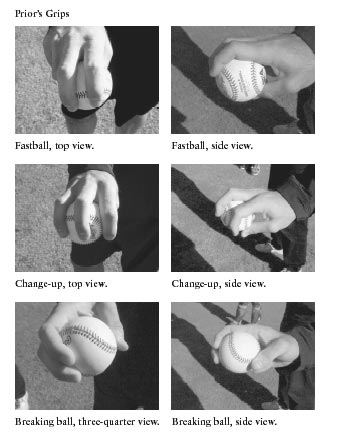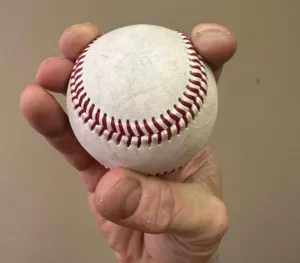If you are searching for How to Grip a Baseball for Different Pitches then this is the perfect article for you!
When it comes to baseball pitching, a pitcher's prowess is truly characterized by their ability to grasp the ball with precision, especially when performing a broad number of pitches. The ability to modify their grip to the needs of each pitch, dictating its direction and pace, distinguishes seasoned professionals from those fresh to the game. We will unravel the delicate art of mastering the grips required for various pitches throughout this comprehensive guide, providing key insights that can catapult your pitching prowess to new heights.
Introduction: How to Grip a Baseball for Different Pitches
Baseball pitching is an art that requires precision and control. The way a pitcher holds the baseball is an important aspect of reaching this precision. The grip influences the pitch's trajectory, movement, and speed, making it an essential part of a pitcher's repertoire.
The Fundamentals of How to Grip a Baseball for Different Pitches
 To become a master pitcher, you must first understand the fundamentals of baseball gripping. The essential grips that serve as the foundation for varied pitches are as follows:
To become a master pitcher, you must first understand the fundamentals of baseball gripping. The essential grips that serve as the foundation for varied pitches are as follows:
- Four-Seam Fastball Grip: This grip involves immediately placing your index and middle fingers on the seams of the baseball, creating a backspin for a straight and fast pitch.
- Two-Seam Fastball Grip: Hold the ball with your index and middle fingers close together along the seams to improve control and induce minor movement.
- Curveball Grip: Bring your middle and index fingers together and perpendicular to the seams. This grip produces topspin and downward movement, which results in a breaking curveball.
- Slider Grip: Place your index and middle fingers slightly off-center on the seams of the ball. For a deceptive slider, this grip provides lateral movement.
- Changeup Grip: Form a circle with your thumb and index finger to use a circle change grip. This grip slows speed and causes late movement, which confuses batters.
Investigating Advanced Pitching Grips
Delving into advanced grips as you develop in your pitching career can dramatically improve your repertoire and keep hitters guessing.
The Split-Finger Fastball: Increasing Your Deception
 The split-finger fastball, or "splitter," is a lethal pitch that combines speed and downward movement. To grasp the splitter, do the following:
The split-finger fastball, or "splitter," is a lethal pitch that combines speed and downward movement. To grasp the splitter, do the following:
- Along the seams, spread your index and middle fingers wider than normal.
- Maintain your thumb beneath the ball and apply gentle pressure to create a split.
- Because of this grip, the ball dives as it reaches the plate, deceiving hitters into swinging over the top.
Embracing the Unpredictable with the Knuckleball
Because of its low spin, the knuckleball dances unpredictably. Although difficult to learn, its grip is rather simple:
 Apply little pressure to the seams using your fingertips.
Apply little pressure to the seams using your fingertips.- During the delivery, keep your wrist loose and relaxed.
- The lack of spin causes unpredictable movement, which confuses even the most seasoned hitters.
Grip Adjustments for Maximum Effectiveness
A little shift in grip can cause substantial changes in a pitch's trajectory and movement, catching batters off surprise.
Changing the Game with Finger Pressure
 You can change the pitch's behavior by varying the pressure provided by your fingers. As an example:
You can change the pitch's behavior by varying the pressure provided by your fingers. As an example:
- Increased Pressure: Applying additional pressure produces more backspin, resulting in a faster fastball.
- Reduced Pressure: By loosening your grip, you can create a sinker or a changeup.
Axis Rotation: Activating Spin Variations
Tilting the ball on its axis can result in a variety of spin and movement patterns:
- Tilted Axis: A slight tilt of the ball during release adds lateral movement, which is ideal for a cutter or slider.
- Top-Back Spin: For a rising fastball, place your index finger slightly behind your middle finger.
The Key to Consistency is Fine-Tuning Your Pitches
 Pitching consistency is dependent on training and perfecting your grips. Here are some expert pitch-perfecting tips:
Pitching consistency is dependent on training and perfecting your grips. Here are some expert pitch-perfecting tips:
- Grip Strength: Play around with grip pressure to find the right combination of control and movement.
- Release Point: Maintain a steady release point to effectively confuse hitters.
- Visualization: Imagine the trajectory of the ball as you grip it to improve muscle memory during execution.
The BioMechanics of Throwing Different Pitches
TopVelocity Can Help Learn How to Grip a Baseball for Different Pitches
 Do you want to improve your pitching abilities and dig deeper into the realm of baseball mastery? Look no further than the TopVelocity Patreon community, which is your ticket to a treasure trove of unique content and personalized coaching that can catapult you to pitching greatness.
Do you want to improve your pitching abilities and dig deeper into the realm of baseball mastery? Look no further than the TopVelocity Patreon community, which is your ticket to a treasure trove of unique content and personalized coaching that can catapult you to pitching greatness.
Joining our Patreon community gives you access to a multitude of excellent tools designed to help you improve your pitching techniques. From learning the proper grip for various pitches to discovering the secrets of a forceful throw, our video library covers every aspect of pitching. Our content caters to all skill levels, whether you're a newbie looking to learn the ropes or an experienced pitcher looking for a competitive edge.
But it isn't all. By becoming a member of the TopVelocity Patreon family, you're getting more than just videos; you're also getting a dedicated remote coach who will walk you through the complexities of each pitch. Consider having a seasoned professional at your side, providing personalized advice and constructive critique to help you develop your skill. Furthermore, our weekly video analysis sessions allow you to receive tailored instructions, guaranteeing that you're constantly growing and fine-tuning your pitching abilities.
Don't let your quest to pitching greatness come to a halt. Join TopVelocity Patreon today to gain access to a world of unrivaled learning, mentoring, and growth. Your journey to mastering all types of pitches begins here, and we're excited to be with you every step of the way.
FAQs: How to Grip a Baseball for Different Pitches
Q: Can I use the same grip on multiple pitches?
A: Absolutely! While the basic grips are a good starting point, little changes can turn a fastball into a sinker or a slider into a cutter. Experimentation is essential.
Q: How long does it take to become proficient in various grips?
A: Pitchers' ability to master grips varies. Regular practice and coaching from skilled instructors might help to accelerate the learning process.
Q: Are there any dangers linked with unusual grips?
A: Incorrect grips can strain your arm and cause damage. It is critical to learn from trustworthy sources and to prioritize your health.
Q: Should I alter my grip based on the batter's abilities?
A: Changing your grip might throw hitters off guard. For example, changing the grip on a curveball against a powerful fastball batter can provide positive outcomes.
Q: What is the key to maintaining consistent grip under varying weather conditions?
A: Using rosin or a drying agent can help you keep a stable grip, especially if you're sweating a lot.
Q: Can I mix and match grips to make new pitches?
A: Certainly! Many pitchers experiment with hybrid grips in order to generate innovative pitches that catch batters off guard.
Final Thoughts on Mastering the Art of Pitch Grips
Gripping a baseball for various pitches is a talent that requires commitment and practice. Remember that every finger placement, pressure modification, and spin variation contributes to your throwing performance as you learn the complexities of pitch grips. You can command the mound and become a pitcher that hitters fear if you have steadfast commitment and a thorough understanding of these strategies.



 Apply little pressure to the seams using your fingertips.
Apply little pressure to the seams using your fingertips.